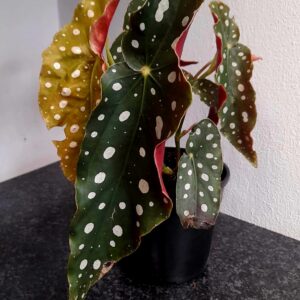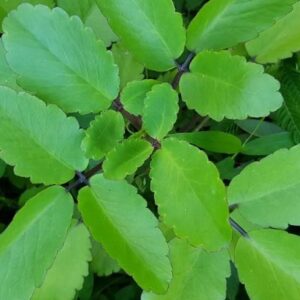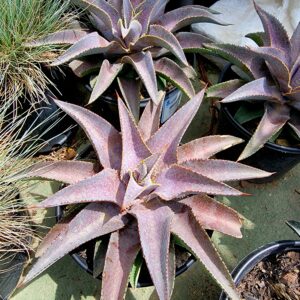Bearded Iris (Iris Germanica) are semi evergreen flowering perennials, grown from rhizomes that flower early summer. They require minimum care, they are extremely drought, heat and cold tolerant; and multiply easily via rhizomes. They have more or less 10 sword shaped flat leaves that grows to resemble a fan. The leaves are bluish-green in colour, about 30cm in height and about 3cm wide that grows in time to form a clump. The Iris fans are sometimes tinted burgundy at the base of the leaves usually on very rich deep red varieties and this sometimes happens on white Irises as well. The flowering stems are long, erect sometimes with a twist or curve in the stem. The Iris flowers have 6 petals all together, with 3 outer petals which are large called falls, they can be gracefully flared or ruffled and falling. The 3 upright erect inner petals are called standards. The roots of the bearded iris are fleshy, and the feeder roots grow close to the soil surface. Bearded Irises have thick bushy or caterpillar like beards that have many short raised hairs that assist in pollination. Bearded Irises come in a wide variety of colours, but bearded Iris do not come in bright red.
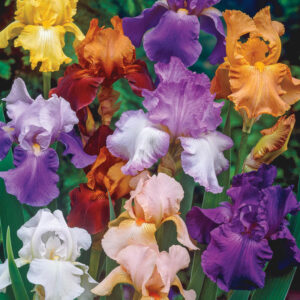
Growing Conditions of Bearded Iris
Bearded Irises are easy to grow, you will be able to enjoy a wide range of flower colours at flowering season that extends for about 2 months of the year, when you grow them in perfect conditions as needed by the species.
Where to Plant Bearded Irises
Bearded Iris requires 6-8 hours of good sun and well drained loamy soil. You can rejuvenate the hard soil in advance, ready for growing bearded Iris by adding lots of old organic matter well under the rhizome at planting time, this will improve the soil quality and drainage. The preferred soil pH is slightly below seven. Some Bearded Iris, especially the dwarf varieties require a period of exposure to cold winters, with nights of under 5 C to produce high quality flower stalks the next summer.
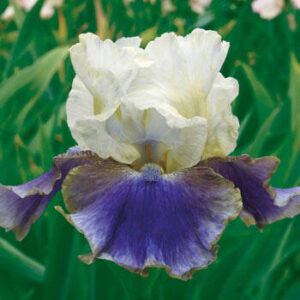
How Do I Plant Bearded Iris Rhizomes
- Dig a small hole to plant bearded Iris rhizome
- Add fertiliser or compost in the bottom of the hole 5 cm under the rhizome
- Form a shallow mound of soil over the fertiliser within the planting hole
- Place the rhizome on top of the mound so that the leaf fan is straight
- Spread the roots over the mound this keeps the rhizome in place
- Press the rhizome down on the mound so it makes good contact with the soil
- Barely cover the roots and the rhizome over with 1 to 2 cm of soil to prevent sun scold
Make sure that your Irises are planted at least 6 weeks before the winter cold set is. After planting bearded Iris thoroughly water the rhizomes. Divide and replant the Iris when the clumps are too congested and size and number of flowers have declined.
- When to Plant Bearded Iris Rhizomes – Iris planting is best done six to eight weeks after flowering that is October to December in South Africa or wait till the cooler months when the weather starts to cool down from mid- April till towards the end of May when the Iris are fully developed and are in a semi dormant state. This is the best time to plant irises after the summer heat subsides in order for them to take root to flower in the following spring. After this, the bearded Iris go dormant for the winter and the bearded iris stop growing.
- How Deep to Plant Bearded Iris Rhizomes– Plant bearded Iris rhizomes just below the soil surface, cover the rhizomes with 1 or 2 cm of soil. Do not leave the rhizomes exposed too much sun otherwise, the rhizomes can scald.
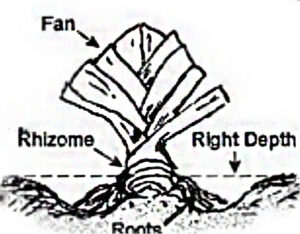
- Spacing Distance Apart– Plant Bearded Iris 40 cm apart, Medium and Dwarf Bearded Iris can be planted 30cm apart.
When the flowers of the Iris plant start to fade, care should be given when you cut off the flower stalks from the base of the plant.
Bearded Iris Water Requirements
Once established the bearded Iris plants require very little water and during a normal summer rain fall very little watering will be needed. When rain is scarce, then deep watering at long intervals is the preferred method of care. Avoid over watering the plants.
- In very dry and hot conditions, it may be necessary to water the plants throughout the summer no more than once a week.
Garden Care and Care of Iris Rhizomes to Prevent Diseases
- Pull away the dead leaves after flowering and keep good Iris care by keeping the irises neat and tidy.
- Do not plant Irises in shady parts of the garden.
- Do not cut down the foliage other than replanting, the foliage is needed to produce flowers for the following season by cutting the foliage this is more likely to reduce next seasons flowers by 15%.
- Every 2-3 years, your bearded Iris clumps will need to be lifted and divided.
It is important to keep the base where the rhizomes are clean and tidy. Remove any dead brown dying, diseased looking leaves often, to prevent snails, fungal spores, slugs around the plant. Snap off the old spent flower stems (they snap off easily) at the base of the rhizome. Do not cut the foliage back anytime while irises are not moved.






